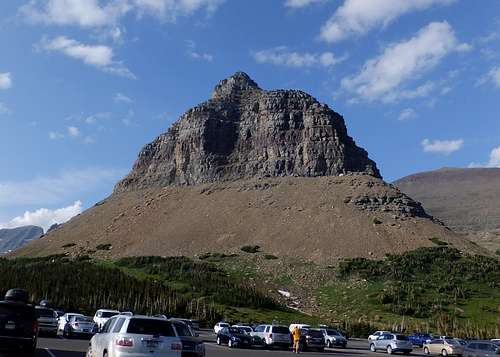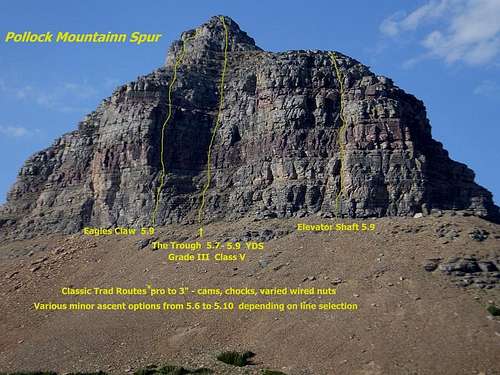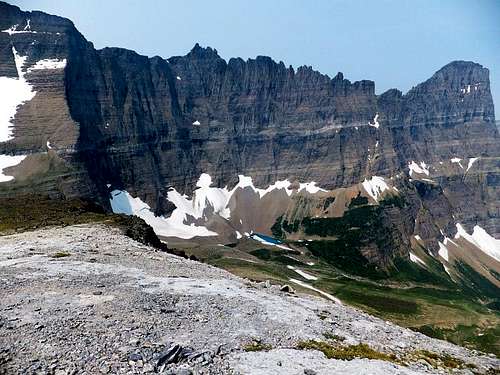|
|
Mountain/Rock |
|---|---|
|
|
48.69923°N / 113.71435°W |
|
|
Trad Climbing |
|
|
Spring, Summer, Fall |
|
|
8325 ft / 2537 m |
|
|
OVERVIEW
Pollock Mountain Spur (8325' at its high point) is the long 1.5 mile ridge extending southerly from Pollock Mountain proper (9190'). The ridge itself is almost impossible to follow either from Pollock Mountain to the Spur's termination or vise-versa. Huge gendarmes and deep chasms block the passage between the two. Extensive time and trouble required rappelling and reascending the ridge line would make the task rather unappealing for most.
Since the 1,000' South Face of the Spur (which this page is about) appears to be so separate of a formation and has its own worthy 5th class challenges, this separate page has been created to document some of the more respectable lines up this wall. The Trough route being one of these. I will document the other lines shown on the photo in detail in my other pages.
*Notes about Technical (5th Class) Climbing in Glacier National Park
Glacier National Park generally is not considered a popular destination for 5th class trad and alpine climbers. Due to unstable rock in many areas and loose scree approaches that can be rather long and arduous most climbers are happy to search for more sport (type) routes elsewhere around Montana. But for the pure mountaineer with a desire to work hard in the alpine zone, GNP offers unbelievable opportunities for endless numbers of technical FA (first ascent) lines up massive vertical walls as high as 4,000. The faces high on these impressive glaciated peaks generally stand around 8,000 to 10,000 feet in altitude. Most of them untouched with the majority of even professional climbers opting to leave them that way. Frankly put, this area of the Rocky Mountains is reserved for the hardcore trad/alpine climber with no fear of marginal rock quality with an intense desire to pursue this style of climbing for the sake of claiming new territory.
Ironically, the summer time peak-baggers with a light day pack find plenty to do in the park since no technical climbing is required on most of these mountains which have an "easy" side that involves no more than a long class 2-3 scree scramble of several miles. BUT for the 5th class climbing enthusiast with big ambitions its a different story. Packing heavy technical gear & seeking new high alpine/trad routes, expect long approaches whether on goat trails, dense untracked forest, snow fields, glaciers and seemingly unending scree slopes before ever reaching the huge plethora of seldom attempted massive faces of Glacier Natl Park.
Being that the rock quality is so questionable and often is more prone to lead unprepared climbers into rather epic circumstances, this area is not recommended for most technical climbers. All that being said, for the advanced climber prepared for all the subjective and objective dangers that mountains can offer, GNP is still virtually an undiscovered and unimaginable playground for the true spirit of high alpine feats. Climbing in winter adds another extreme dimension to an already unstable environment requiring the trad /alpinist to exercise every physical and mental faculty he possesses with the greatest of skill and wisdom.
Bottom line... don't attempt technical 5th class climbing here unless you got ALL your **** together. Getting RESCUED or worse ... losing your life because of your lack of abilities and knowledge is an unnecessary event. Not to mention it stains the greater climbing community's reputation & name. "If in doubt, just don't do it." Because... no climb is worth a tragic ending.
Getting There
Access :
** Current Access Issue: Big Horn Sheep Closures
Details (Right Click & Open in New Window)
Continue Reading:Glacier Natl.Park can be accessed via many entrance sites. Including West Glacier, Two Medicine, Polebridge, Camas Crk, Cut Bank, St Mary, Many Glacier, and Chief Mtn.

The Pollock Mtn Spur Routes are reached via the Going To The Sun Road and located directly north of the Logan Pass Visitors Center parking area. The Spur is the main face visible from the visitors center parking lot.
Route
Note: This wall on the South Face of Pollock Mtn Spur is probably one of the easiest approaches to 5th class climbing in the park. As such, thousands of visitor at Logan Pass will notice your presence and inevitably someone will make mention of you "being off trail" to the attending park ranger. Thus, its always a good idea to let the rangers at Logan Pass know you are experienced climbers and are fully equipped to accomplish this climb before you head up. This will avoid much question and allow the rangers to reassure visitors you are "experts". Again because of the climbs proximity to the Visitors Center and to show good climbing etiquette, be careful to avoid walking through the signed areas stating "No Foot Traffic" which are adjacent to the roadway.
Approach: Ascend the scree field up to the base of the main face to access the climb(s). The best descent route (see route description) is down climbing a 3rd-4th class gully east of the climb. If the wrong gully is chosen, multiple rappels may be necessary.
Details: The Trough follows an obvious depression in the south face of the Pollock Mtn Spur. Many variations and lines can be done up this wide trough. Generally 5.7 - 5.9 moves with spacious intermittent ledge systems for belay stations. This is decent rock for GNP. Although, lots of loose rock will be found on belay ledges. Careful rope management is essential as to not send rock down onto your belayer. The Crux moves on this route will depend on line chosen. Generally speaking, slightly left of center is easier. Right of center affords more overhangs and vertical. The main part of the wall can be climbed in 4-5 pitches and the climbing party can opt to traverse off the face and easterly to the descent route. If the full climb is to be finished, scramble up 2nd & 3rd class ledges to the base of another head wall and complete the last two pitches to reach the top of the South Face. Read about other climbs I have established on this same formation at The Mountain Project.
Descent: From the top of the Pollock Mtn. Spur, descend class 2 scree ledges south easterly carefully avoiding down climbing steep time consuming cliff bands until above several obvious gulleys. From here, the descent is via the 3rd gulley system east of the main face. Don't descend the first two gulleys closest to the main face as rappels would be required. No rap points have been established and you would most likely be leaving some trad gear behind. Third gulley starts with an easily down climbed 20' chimney at the west edge and is a 3rd-4th class from there on down to the Going to the Sun Road near Logan Pass.
When to Climb
Spring, Summer, and Fall are amazing times to climb in the park. Winter climbing around the Logan Pass area involves a long ski up the going to the sun road. Most climbers opt to wait for the opening of the Going To The Sun Road which is usually by mid to late June.
Essential Gear
Various Trad Gear: wires, hexes and cams up to 3"-4". When I did the FA on this route in 1994, I free soled it and did it in about 2 hours car to car. When repeating the climb in July, 2015, I took a 50m rope and a small rack of wires, a few hexes and a couple cams. There are no bolts or fixed gear on the route. No fixed Anchors. Carry a few pitons for rapping off in emergencies.
No bolts are placed on this route or any technical route in Glacier National Park for that matter to the best of my knowledge. The park service frowns upon any bolting or rock degradation of any kind. Piton placement is accepted for emergency use only. (ie... bailing off routes)
External Links
Photos and More Info on Routes:
The Mountain Project - The Trough
Pollock Mountain Spur Routes (Face Book Album)




